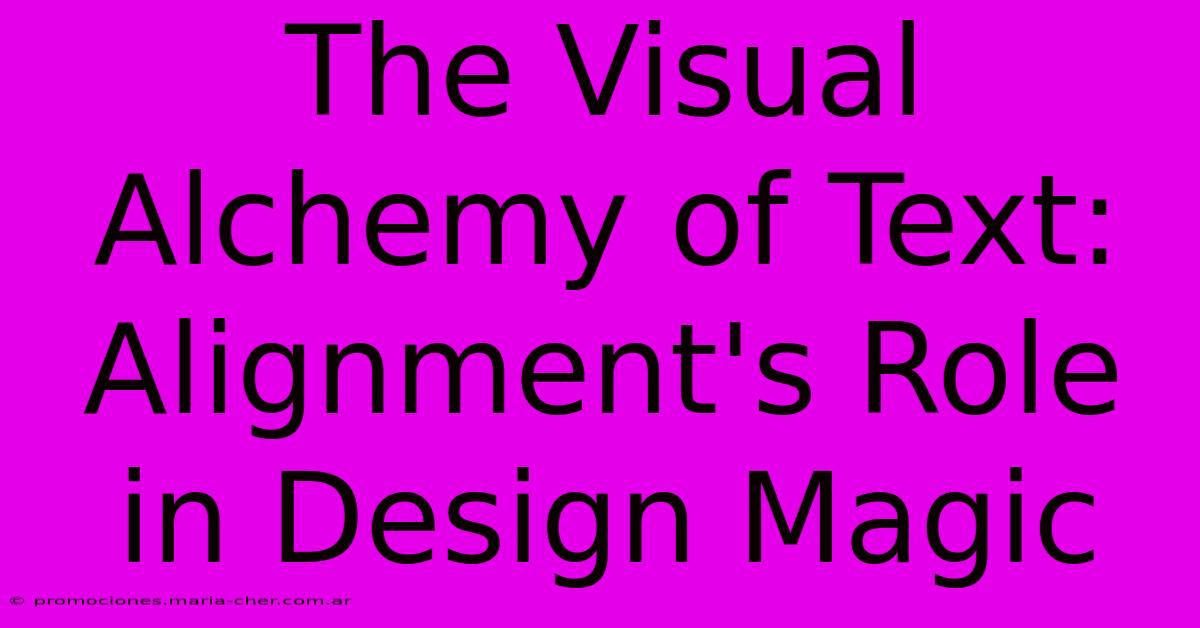The Visual Alchemy Of Text: Alignment's Role In Design Magic

Table of Contents
The Visual Alchemy of Text: Alignment's Role in Design Magic
Have you ever looked at a beautifully designed website or a captivating print piece and wondered what made it so appealing? Beyond the color palette and imagery, the subtle magic of text alignment plays a crucial role in creating a harmonious and effective visual experience. Understanding how to wield this powerful design tool can transform your layouts from chaotic to captivating. This article delves into the visual alchemy of text alignment, revealing its power to enhance readability, guide the eye, and ultimately, elevate your design.
The Unsung Hero: Why Alignment Matters
In the world of design, text isn't just information; it's a visual element. Proper alignment isn't merely about neatness; it’s about creating a sense of order, balance, and professionalism. Poorly aligned text can instantly make a design look amateurish and difficult to read, while well-aligned text contributes to a polished, professional, and user-friendly experience. Think of it as the invisible architecture supporting the aesthetic appeal of your design.
Readability Reigns Supreme
The primary function of text is communication. Proper alignment significantly impacts readability. Left-aligned text, the most common type, mimics our natural reading patterns, making it easy to follow. Center-aligned text, while aesthetically pleasing in small doses, can be difficult to read in large blocks. Right-aligned text is often used for smaller elements like captions or short lists but rarely for large blocks of text. Justified text, though giving a clean, even appearance, can sometimes create awkward gaps and uneven spacing, potentially hindering readability. Choose the alignment that best serves your content and intended audience.
The Alchemy of Alignment: Different Types and Their Effects
Let's explore the various types of text alignment and their visual impact:
1. Left Alignment: The Workhorse
Left alignment is the most common and generally the most readable option. Its familiarity and ease of reading make it perfect for body text, articles, and large blocks of information. The consistent left edge creates a visual anchor, guiding the reader smoothly down the page.
2. Center Alignment: The Focal Point
Center alignment is best used sparingly. It can be highly effective for headlines, titles, short quotes, or single sentences that need to stand out. However, using it extensively for body text will strain readability.
3. Right Alignment: The Supporting Act
Right alignment is primarily used for shorter elements like page numbers, captions, or lists of items. It's rarely suitable for lengthy blocks of text. Like center alignment, it should be employed strategically to enhance, not detract, from the overall design.
4. Justified Alignment: The Balancing Act
Justified alignment, where text is aligned to both the left and right margins, creates a neat, even appearance. However, it can lead to uneven spacing between words, making it less readable than left alignment. Use justified alignment cautiously, perhaps for formal documents or sections where a very clean, balanced look is paramount.
Mastering Alignment: Tips for Design Success
- Consistency is key: Maintain consistent alignment throughout your design. Switching between alignments randomly will create visual chaos.
- Consider the context: The best alignment depends on the content and its purpose. A large block of text requires a different approach than a short headline.
- Use whitespace effectively: Don't overcrowd your design. Whitespace around aligned text enhances readability and visual appeal.
- Test and iterate: Experiment with different alignments to see what works best for your specific design. User feedback can be invaluable.
Conclusion: The Art of Visual Harmony
Mastering text alignment is an essential skill for any designer. It's a subtle yet powerful tool that directly impacts readability, visual hierarchy, and the overall success of your design. By understanding the nuances of different alignment types and their impact, you can unlock the visual alchemy of text and create designs that are both beautiful and effective. Remember, the seemingly small details, like text alignment, often contribute most significantly to the overall impact and memorability of your work. So, embrace the power of alignment and watch your designs truly come alive!

Thank you for visiting our website wich cover about The Visual Alchemy Of Text: Alignment's Role In Design Magic. We hope the information provided has been useful to you. Feel free to contact us if you have any questions or need further assistance. See you next time and dont miss to bookmark.
Featured Posts
-
The Invisible Maestro Discover The Otolaryngologist Reshaping Your Ear Nose And Throat
Feb 07, 2025
-
Elevate Your Fashion With A Second Hole Piercing The Ultimate Guide For Style Savants
Feb 07, 2025
-
Gold Without The Guilt Exploring The Ethical And Affordable Appeal Of Vermeil
Feb 07, 2025
-
Decorate On A Dime Discover The Unbelievable Price Of Baby Breath Bouquets
Feb 07, 2025
-
Discover The Future Of Font Technology Futura Now Trial The Ultimate Upgrade
Feb 07, 2025
